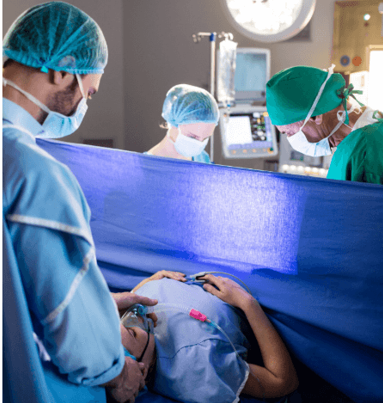Treatment Overview
The Laser-Assisted Laparoscopic Hysterectomy (LALH) in Korea is an advanced minimally invasive surgical procedure that uses laser technology alongside laparoscopic techniques to remove the uterus with exceptional precision. This approach combines high-definition laparoscopy with medical-grade surgical lasers, offering improved accuracy, reduced bleeding, and faster recovery compared to conventional hysterectomy methods.
Korea is a global leader in laser-assisted gynecologic surgery, using advanced systems such as CO₂ lasers, holmium lasers, and Nd:YAG lasers integrated with high-definition laparoscopic imaging. These technologies allow surgeons to perform delicate tissue dissection and vascular sealing with minimal thermal damage to surrounding tissues, making this procedure highly effective and safe.
Purpose & Benefits
The Laser-Assisted Laparoscopic Hysterectomy aims to treat uterine conditions with precision and minimal invasiveness while supporting a faster and more comfortable recovery.
Purpose:
- Treat symptomatic uterine fibroids, adenomyosis, endometriosis, or uterine prolapse
- Manage abnormal uterine bleeding
- Address pelvic pain related to gynecologic conditions
Benefits:
- Enhanced precision with laser-guided tissue removal
- Reduced bleeding due to laser cauterization
- Minimal thermal damage to surrounding tissues
- Smaller incisions for minimal scarring
- Shorter recovery time and reduced post-operative pain
- Lower risk of infection and adhesions
Ideal Candidates
Laser-assisted laparoscopic hysterectomy is suitable for women who:
- Require uterine removal due to benign or early malignant conditions
- Have fibroids, adenomyosis, or endometriosis causing pain or abnormal bleeding
- Prefer a minimally invasive approach with reduced scarring
- Seek quicker recovery times and less post-operative discomfort
- Are in good general health and able to undergo laparoscopic surgery
Candidates undergo detailed preoperative evaluation, including imaging and laboratory tests, to ensure suitability for this advanced procedure.
Possible Risks & Complications
Although laser-assisted surgery is highly precise, possible risks include:
- Minor bleeding or infection
- Thermal injury to surrounding tissues (rare due to advanced laser control)
- Injury to bladder, bowel, or ureters
- Anesthesia-related complications
- Formation of adhesions or scar tissue
Korean medical centers minimize these risks by combining advanced laser technology with strict surgical protocols and highly skilled surgeons.
Surgical Techniques Used
Korean specialists use cutting-edge laser and laparoscopic techniques for maximum safety and effectiveness:
- CO₂ Laser Dissection: Allows precise cutting with minimal bleeding.
- Holmium Laser Technology: Ideal for delicate tissue ablation with controlled depth penetration.
- High-Definition Laparoscopy: 3D or 4K imaging systems for enhanced visualization.
- Energy-Sealing Devices: For effective vessel sealing during tissue removal.
- Single-Port Laser Laparoscopy: Minimally invasive access through one incision for better cosmetic results.
Korea’s use of AI-guided imaging and robotic-assisted laser systems further enhances surgical precision, safety, and patient outcomes.
Recovery & Aftercare
Recovery following LALH is generally rapid due to the minimally invasive approach and precision laser technology. Most patients stay in hospital for 1–2 days, with light activities resuming within a week.
Aftercare includes:
- Pain management and wound care
- Avoiding heavy lifting or strenuous activity for 4–6 weeks
- Follow-up visits with imaging to ensure proper healing
- Pelvic floor rehabilitation and lifestyle guidance
Many Korean hospitals provide personalized recovery programs, combining medical supervision with nutrition, physiotherapy, and emotional support.
Results & Longevity
Patients typically experience permanent resolution of symptoms such as abnormal bleeding, pelvic pain, and pressure. Laser-assisted technology minimizes tissue trauma, which promotes faster healing and reduces scar tissue formation. With proper aftercare, the results of LALH in Korea are long-lasting, and patients enjoy enhanced pelvic health and quality of life.
Treatment Process in Korea
Korea is recognized globally for combining advanced laser technology with world-class surgical precision in gynecologic procedures. The process includes:
- Comprehensive Preoperative Evaluation: Imaging (3D ultrasound, MRI) and hormonal assessment.
- Customized Surgical Planning: Based on patient anatomy and condition severity.
- Laser-Assisted Laparoscopic Surgery: Using CO₂ or holmium laser integrated with high-definition imaging for maximum accuracy.
- Postoperative Care: Comprehensive recovery support including physiotherapy, diet planning, and hormone monitoring.
Korean medical centers also offer multilingual support, luxury recovery suites, and patient-centered services, making Korea one of the top destinations for laser-assisted hysterectomy.
Cost Range
The cost of a Laser-Assisted Laparoscopic Hysterectomy in Korea generally ranges between USD 7,000 and 14,000, depending on:
- Hospital selection and surgeon expertise
- Complexity of the procedure
- Type of laser technology and equipment used
- Postoperative care package
This cost typically includes preoperative diagnostics, surgery, anesthesia, hospitalization, and aftercare support.
Popular Clinics
- Severance Hospital (Yonsei University Health System, Seoul): Pioneer in laser-assisted gynecologic surgery with cutting-edge equipment.
- Asan Medical Center (Seoul): Offers advanced laser laparoscopic hysterectomy with a focus on safety and recovery.
- Samsung Medical Center (Seoul): Integrates laser precision with robotic and high-definition laparoscopic systems.
- CHA Gangnam Medical Center: Known for minimally invasive and laser-assisted gynecologic surgeries.
- Ewha Womans University Medical Center: Provides high-quality laser-assisted hysterectomy with comprehensive patient care programs.




